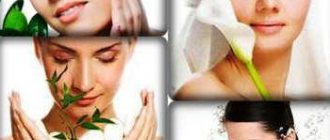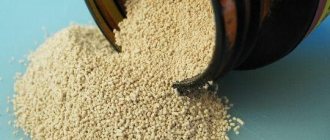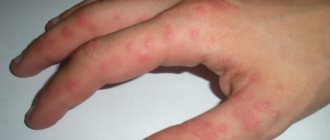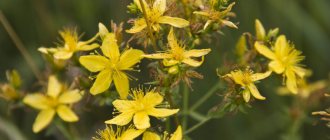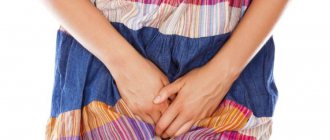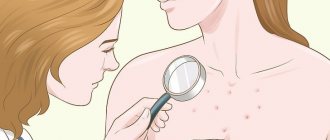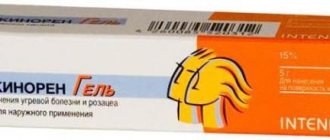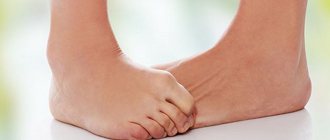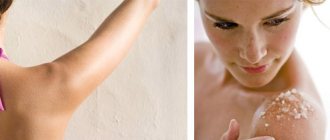Good afternoon, dear parents and teenagers! Acne appears on the back of a teenager - today we will tell you what to do and how to cure it. Internal changes associated with growing up, which actively occur in the human body during puberty, entail external consequences that cannot be ignored, and sometimes they cause a lot of inconvenience to a teenager.
Adolescence is almost always accompanied by severe acne. The areas most affected by acne are the back, face and chest.
While a rash on the face is easier to deal with, acne on a teenager’s back may not be so easy to treat.
But it is still possible to cope with them. So, let's look at what to do if a teenager has pimples on his back.
What are the types of acne on a teenager's back?
- Small pimples on the back may appear as a response to constant wearing of synthetic clothing. In this case, the skin does not receive air, but sweats quite a lot. Such pimples appear immediately over a large area and disappear after proper hygienic care.
- If pimples appear along with severe itching, this may be a sign of an allergic reaction, for example, to a cosmetic product used by teenagers. The same allergy can appear to soap, shower gel, or powder that was used to wash clothes.
- Large white pimples often appear on the back , which some also call wen. Few people know, but the top layer of skin on the back is quite dense, and there are a large number of sebaceous glands located here. Such glands are literally clogged with subcutaneous fat and because of this, noticeable compactions appear. And if microbes do not get into such a pimple, then it can remain in this state for a very long time.
- On the back, like on any other part of the body, open comedones or blackheads may appear.
- Red, inflamed pimples often appear here , but with proper treatment you can quickly get rid of them.
- If you don’t react to the appearance of pimples, then they can develop into real ulcers . They can reach large sizes and are quite difficult to cure.
Causes
The main reason for the appearance of acne in adolescents, both on the back and on the face, is called hormonal changes in the body. Moreover, this affects the work of all organs, but especially affects the skin.
The sweat and sebaceous glands work especially actively during this period. And increased sweating, poor hygiene and the addition of microbes lead to the appearance of acne. But what else can cause rashes on the back?
- Allergic reaction.
- Incorrectly chosen clothes. It has been noticed that acne on the back most often appears in those who prefer to wear synthetic clothes.
- Poor nutrition. Excessive consumption of sweets, fast food, and fatty foods leads to the fact that the body tries to get rid of everything unnecessary not only through the kidneys and liver, but also through the skin.
- Diseases of the stomach and intestines, glands, kidneys, liver.
- Stress.
- Reduced immunity.
- Violation of personal hygiene rules.
Causes of acne on the back in children under one year old
In children under one year old, pimples on the skin are called prickly heat. This disease appears when hygiene rules are not followed, when the baby sweats excessively, as well as from overheating. The rash can also cause allergies.
If there is any rash on the baby’s skin, it should definitely be shown to a pediatrician. Moreover, few parents know that acne on a child’s body can be symptoms of various serious infections - chickenpox, measles, rubella, scarlet fever.
But purulent acne can cause damage to the body by staphylococcus.
Causes of acne on the back of boys and girls
From the moment puberty begins, real acne appears on the body of many boys and girls. As a rule, they stop bothering you after you reach 20 years of age, although in guys this rash may last longer.
And the main reason for acne is hormonal changes. Since it is impossible to influence this cause, it is only recommended to carefully monitor body hygiene and use preventive cosmetics.
In adults
The causes of back acne in adults are completely different. Moreover, it has been noted that most often this attack occurs in men. And there is an explanation here.
The skin on the back of men is dense, and there are also a large number of hair follicles. The sebaceous and sweat glands work very actively. And it is the hair follicles that can become inflamed due to being clogged with fat.
Other reasons include:
- Smoking.
- Drinking large amounts of alcohol.
- Poor nutrition.
- Stress.
What about women? Yes, acne also appears on their back, but very, very rarely. Women take care of their personal hygiene better than men, eat right and cope better with stressful situations.
But acne can appear due to one or another gynecological disease.
Why does a rash appear on the back?
The cause of acne on the back may be poor functioning of the liver and excretory system as a whole.
A rash on the back in infants and in adolescence appears as a result of prickly heat, a condition caused by overheating of the skin. In a newborn baby, until about 2-3 months of age, the process of thermoregulation of the body is still being established. Therefore, babies need to be dressed according to the weather and not wrapped up in the hot season.
A rash on the back of a teenager or acne is a sign of hormonal changes in the body, which also affects the skin. During adolescence, many treatment interventions are ineffective. Therefore, the only right decision is to wait it out: after the hormonal levels become stable, the skin symptoms will disappear.
Other non-pathological causes include insect bites, which affect people of all ages, including children and teenagers. Particular activity of insects is observed in the summer. The appearance of pimples can occur in any area of the body: on the face, shoulders, lower back, chest, abdomen, limbs, etc.
If red pimples appear in a newborn or one-year-old child who is breastfed, a possible cause of the symptom is an allergic reaction of a food nature. As a rule, a skin rash is caused by the inclusion of exotic fruits and dairy products in the diet of a nursing mother.
An allergic reaction also develops to clothing material (usually synthetic), household chemicals, including washing powder. For example, pimples on the lower back of a child, not accompanied by a fever, occur when they come into contact with the elastic of pants that have been washed with the wrong product.
Watery rashes in girls and boys up to one year and after are symptoms of an infectious disease. It could be chickenpox or chickenpox. Pimples contain watery exudate, are located throughout the body, and can itch. The pathology is considered contagious. For this reason, the child is isolated from healthy children who do not have specific immunity to the disease.
The rash may be caused by childhood infections.
Other possible infectious diseases that occur with a rash on the skin include:
- Rubella. The rashes look like round or oval neoplasms with a pinkish tint. Small pimples first form on the skin of the face and neck, then spreading to other areas of the body.
- Measles. The pimples have the form of rounded formations of gray-white color, which at the initial stage of the disease appear on the mucous membranes of the lips. The pathology occurs with an increase in temperature. Over time, the rash spreads to the cervical, thoracic, and dorsal regions.
- Scarlet fever. The first areas to be affected are the back, groin, and armpits—the areas that sweat the most. As the disease progresses, the rash spreads to the extremities.
- Sudden exanthema. Infectious pathology develops against the background of exposure to herpes virus infection. Children under 5 years of age are susceptible to the disease.
- Erythema. The development of pathology is influenced by parvovirus B19. Approximately 4-5 days after the pathogen enters the body, a rash appears on the face, spreading to other areas of the body. The disease is more often diagnosed in preschool children.
- Molluscum contagiosum. White pimples, similar to blackheads, have a diameter of several millimeters. The disease is highly treatable.
Less commonly, a rash on the back occurs with impetigo. Pathology is diagnosed in children from 2 to 7 years old. At the initial stage, red spots form on the skin, which turn into purulent blisters. The general temperature rises, nearby lymph nodes enlarge.
Treatment of back acne in teenagers
What to do when a teenager has acne all over his back? In this case, it is better not to practice self-medication, since first of all it is necessary to establish what caused the disease.
Therefore, if you want to get rid of acne and other rashes once and for all, you should definitely visit a dermatologist or cosmetologist.
If after consultation no diseases of the internal organs, especially the stomach and intestines, were identified, then you can use the following methods of therapy:
- Diet.
- Careful hygienic care.
- The right choice of cosmetics.
- Use of medicinal ointments.
Diet
Diet therapy plays a huge role in the treatment of acne in adolescents. At this age, you should stop eating unhealthy foods such as smoked meats, spicy foods, fatty foods, chips, soda, sweets, and fast food. In some cases, rashes on the back may appear even after drinking large amounts of cow's milk.
Normalizing nutrition will help
To treat acne in a teenager, you will need to follow a diet for at least some time. No strict restrictions, but only normalization of nutrition.
That is, if your offspring ate French fries, chips, and deep-fried foods, then this has to end.
It is necessary to exclude from the diet all deep-fried or high-fat foods. Fried and at the same time fatty foods help to strengthen the work of the already active sebaceous glands.
In addition, it is necessary to exclude spicy foods - they irritate the sweat glands. What enhances their work? Another important dietary prohibition is sweet foods.
It is better to eliminate sugar altogether for a while, and instead offer the teenager fructose or honey.
Types of acne and their treatment
Unfortunately, it is impossible to get rid of such a phenomenon as increased oily skin in adolescents during puberty. However, proper treatment, diet and skin care will help get rid of rashes or significantly reduce their number. But treatment also depends on the type of acne.
From small ones
If a large number of small pimples appear on your back, then it is not advisable to use ointments or masks here.
The best help in this case is a bath with potassium permanganate, sea salt or chamomile decoction.
If desired, you can use salicylic-zinc paste. It can be applied to a large surface of the skin at once.
You can use boric or salicylic acid, calendula, from which the tincture is made, as well as a drug such as chlorhexidine.
From subcutaneous
The most difficult to treat are those pimples and blackheads that are located under the skin and have no way out. Therefore, drugs are used here to absorb and clean pores.
It is best to use a simple compress.
- A large spoon of honey + a small spoon of lemon juice + 10 drops of tea tree oil.
- Mix everything thoroughly.
- Soak a napkin with this mixture.
- Apply on pimples.
- The duration of the compress is several hours.
From purulent
Purulent pimples are very, very painful. This is due to the proliferation of bacteria and the development of inflammation. They cannot be squeezed out. But you can speed up their maturation. And also with the help of ointments it is possible to draw out the pus.
To do this, it is best to use ointments such as:
- Ichthyol.
- Vishnevsky.
Among the traditional methods, it is recommended to use aloe juice, grate potatoes, and lubricate with iodine.
What not to do for teenage acne
In pursuit of quick relief from acne, many teenagers make many mistakes. Let's clarify what not to do in the fight against rashes on the back.
- You should not use antibacterial soap every day. It dries out the skin greatly, resulting in even more acne.
- You should not squeeze pimples, as the infection can also be spread all over your back. The deeper layers of the skin can also be affected.
- Do not use hard washcloths, scrubs or peeling. This can cause inflammation to worsen.
- You cannot use antibiotics without a prescription, as this will lead to the microbes developing resistance over time and it will no longer be possible to overcome them.
How to get rid of the problem
If rashes appear on your hands, the best option would be to consult a specialist. However, before going to the doctor, it is worth taking some measures at home. The first thing you need to do is keep the acne area clean. This will help avoid secondary infection.
Purulent pimples, like any other, must be carefully washed with warm water and soap and dried with a clean towel or napkin. It is advisable to carry out such procedures in the morning and evening.
Fungal diseases are characterized by inflammation
At the same time, you need to ensure the cleanliness of clothes that come into contact with the area where there are acne. It is best to wear clothes made from natural fabrics, as synthetics further irritate the skin.
When going outside, it is best to cover the rash with a long sleeve from dirt and dust.
Experts advise eating right and taking vitamin complexes.
The following vitamins and microelements are best suited:
- A (promotes rapid healing and protection of the skin);
- E (maintains the skin of the hands in a healthy condition);
- chromium (reduces the number of bacteria);
- selenium (accelerates recovery during treatment).
Folk remedies are popular in the fight against acne on the hands. The affected areas can be treated with aloe juice, viburnum, calendula tincture, salicylic acid, a decoction of herbs with an anti-inflammatory effect (nettle, chamomile, sage, string).
Potassium permanganate baths give good results, and you can dry out pimples using white or blue clay.
Prevention
Prevention helps avoid the appearance of back acne in teenagers. Moreover, there is no need to take any special measures for this. Everything is very simple:
- Wear clothes only from natural fabrics.
- Bedding should also be made only from natural material. It is recommended to wash bed linen once a week.
- Take a shower 2 times a day. Be sure to use scrubs twice a week. But only if there are no acne.
- Establish proper nutrition, excluding fatty, fried and spicy foods.
Cosmetic professional procedures
Caring for teenage skin should be comprehensive. In addition to home procedures, you can also use the services of beauty salons if possible.
Today, more than a dozen different professional procedures are provided for the effective treatment of teenage rash.
There are cheaper options, but there are also those that not everyone can afford.
For example, chemical peeling for problem areas of the skin is an effective and inexpensive procedure that works both for the prevention and treatment of acne, and costs tens of times less than a session of equally effective mesotherapy.
Here are some salon treatments that are most popular and effective in combating teenage pimples and acne.
- Cryotherapy.
This is a relatively “young” method in cosmetology, which allows you to almost completely get rid of acne in just 5-7 sessions. This method is based on the use of liquid nitrogen, the temperature of which is about -250 degrees.
Performing this procedure at home is impossible, as appropriate equipment is required.
- Peels – chemical and mechanical.
Either one or the second version of peelings can be performed both at home and in a beauty salon.
The principle of both peeling options is based on the removal of keratinized scales of the epidermis, which clogs the pores, which provokes the appearance of sebaceous plugs, which, when inflamed, form acne on the back of a teenager.
Chemical peeling allows you to cleanse the skin of dead epidermal cells using various acids, while mechanical peeling cleanses it using abrasive particles.
- Ozone therapy.
Recommended to enhance the effect of treatment with antibacterial ointments, as an adjuvant. Ozone therapy is a procedure that is used in the treatment of various diseases, and not only skin diseases, therefore only a doctor can prescribe any specific type of ozone therapy.
